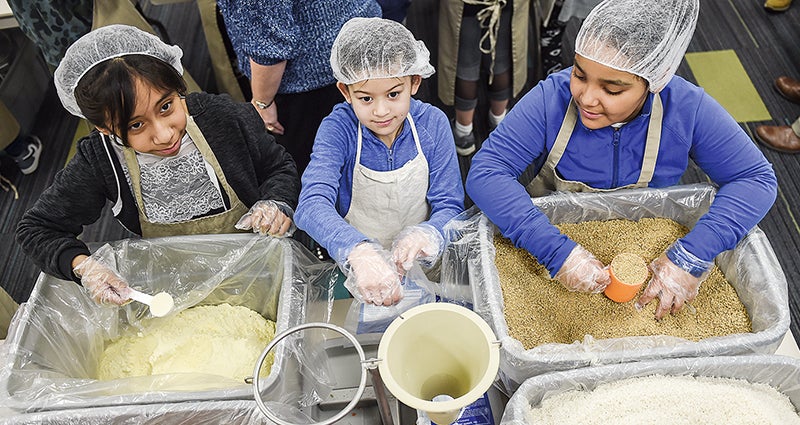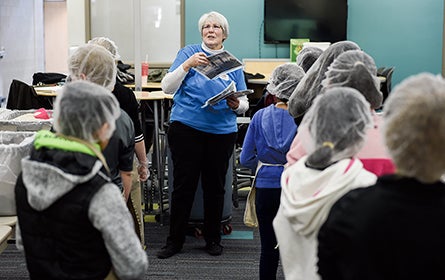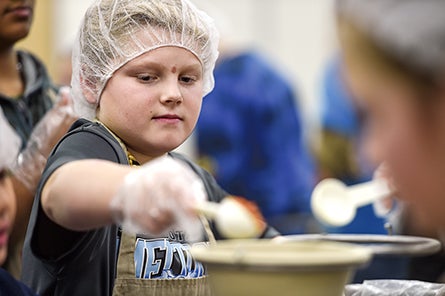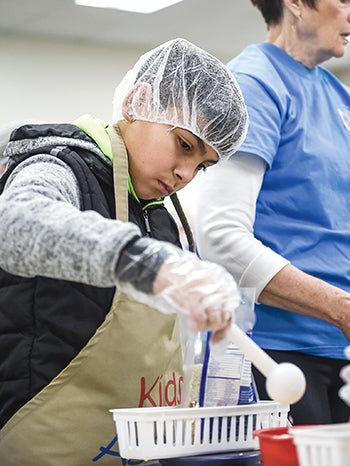Hope for the Hungry; IJ Holton students come to the rescue
Published 9:12 am Friday, January 4, 2019

- Sarai Hernandez Garcia, from left, Kaylynn Valle and Italia Molina begin packaging for Kids Against Hunger Thursday morning at IJ Holton Intermediate School. Photos by Eric Johnson/photodesk@austindailyherald.com
Learning how others can be affected by hunger, IJ Holton Intermediate School students lent a helping hand on Thursday.
Students wore aprons, caps and gloves while carefully measuring out the proper amounts of food and nutrition into bags, which were then sealed and packaged into cases that will eventually be sent out to countries such as South Sudan. Each bag has about six servings and provides a day’s worth of essential nutrition with long-grain rice, vitamin-fortified crushed soy, dehydrated blend of six vegetables, and vitamin and mineral powder. Each of the packages are able to be seasoned with different flavorings dependent on where the individual lives around the world.

Carol Brown of Kids Against Hunger tells kids of the important work they are doing by helping Thursday morning at IJ Holton Intermediate School.
“The purpose of our work with Hope for Hunger was to help build community in our school around an event that helps others,” said Becky Gerdes, IJ Holton staff member and organizer of the event. “By helping others, we are building a positive school culture. It is a rewarding and empowering experience for students to work together.”
Quickly, IJ Holton was meeting its goal of filling around 50 cases, which would equal about 10,800 meals. To see students develop a sense of community service in this regard, and to grasp the concept of helping others wasn’t a surprise. Some even gave up recess to continue packaging cases of food for those hungry.
“They love it,” said Carol Brown, one of the leaders for Kids Against Hunger. “They gave up their recess to come back and help package more meals. I’m so excited that they caught the vision of volunteering. …I love seeing their enthusiasm. They’re good workers and they work together as a team.”

I.J. Holton Intermediate School fifth-grader Isaac Anderson dumps a scoopful of dried veggies into the mix as students took part in Kids Against Hunger Thursday morning at the school.
One out of six children (about 100 million) in developing countries is underweight, and poor nutrition causes nearly 45 percent of deaths in children under the age of five, which is about 3.1 million children each year, according to the Food Aid Foundation.
Kids Against hunger doesn’t usually ship the meals packaged by volunteers directly to other countries, but relies on partners who can deliver the food safely to the destination. The nonprofit also partners with organizations to promote continued sustainability with setting up schools and teaching local people sustainable farming techniques to improve health.
For teachers, having their classes be able to participate in an event like Hope for Hunger, was also part of the curriculum that students were learning. They were able to apply skills such as weighing and measuring, as well as learning how to use equipment to seal cases and learning more about humanitarian need for people living in refugee camps.

Christopher Rivera levels out the weight of a package for Kids Against Hunger Thursday at IJ Holton Intermediate School.
“Many of my students didn’t know the conditions that people in South Sudan were living in,” said Lexie Stallkamp, a fifth grade language arts and social studies teacher. “They’re learning about how they can help others and be a huge part of helping an issue. It sort of builds them up, and is key to having a great classroom environment.”
Fifth grade student Ryan Faulkner was deeply affected from learning about hunger and how others struggle to survive.
Having a chance to help others struggling to survive, it was a lesson that can’t be learned from the textbook.
“It made me feel sad that a child or an adult could die of hunger issues,” Faulkner said. “I could even die from hunger, and someone could die from starvation every day. We’re going to try and reduce the number of deaths. I’m happy to be helping people. I want to keep doing this when I grow up.”


